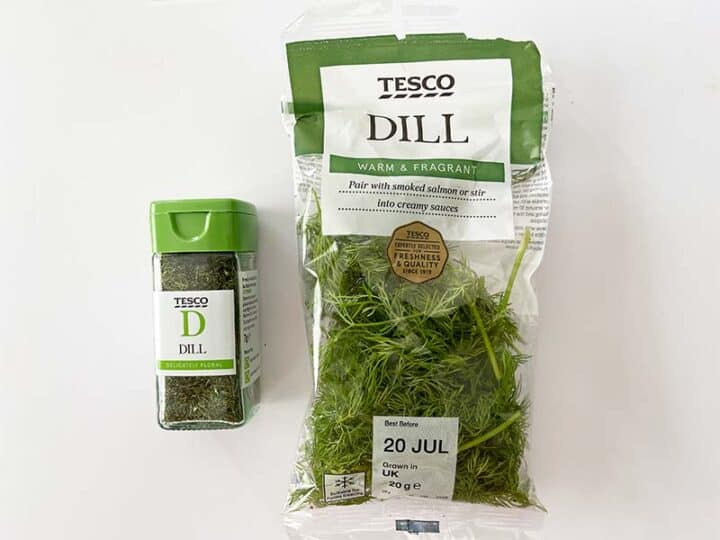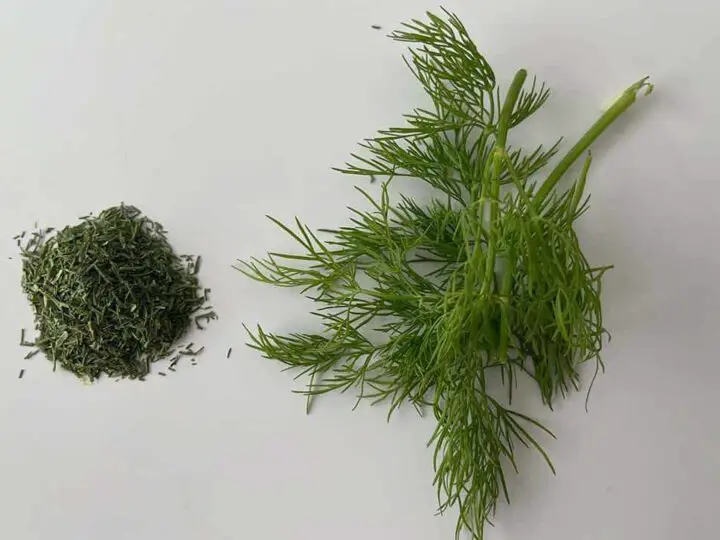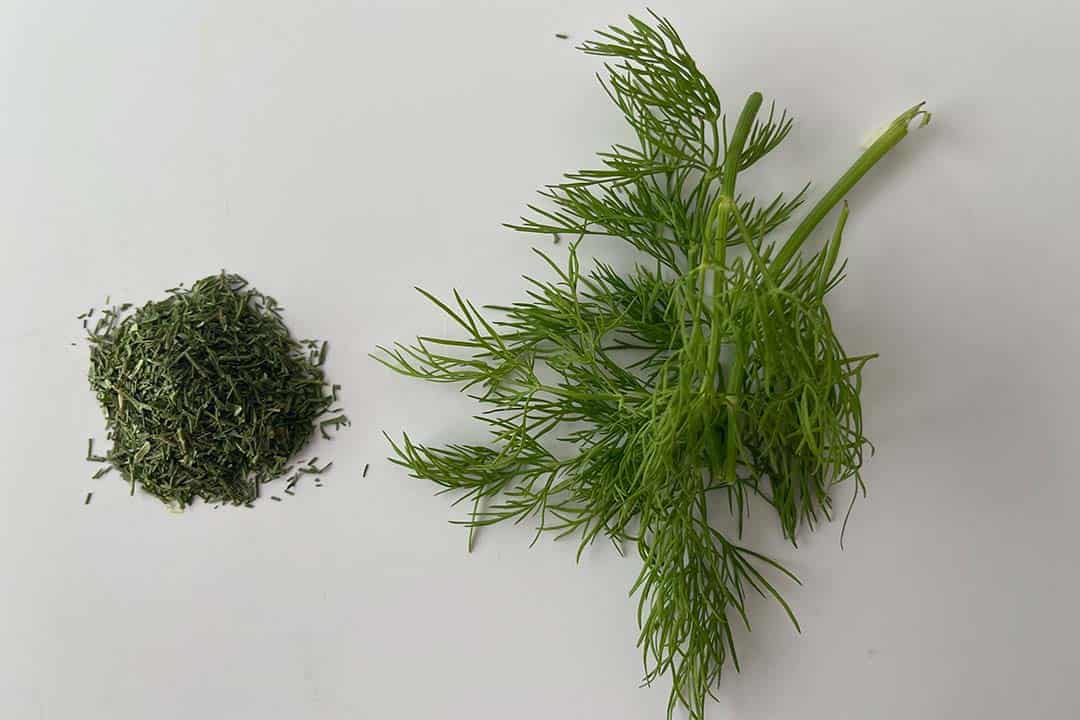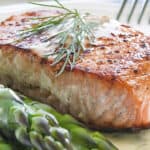Last Updated on 19th June 2023 by
What is Dill?
Dill is a strange kind of herb that changes flavour depending on the season. In the summer, it becomes bitter and doesn’t have much of the aromatic flavour that some people may associate it with. The taste has “bolted” or changed during the hot weather, because in colder weather it is more aromatic and tastes slightly like liquorice.
Most people think of dill weed in conjunction with pickles or potato salad, and it’s often the bitter taste of summer dill that people most associate with the herb. There are lots of recipes you can use it in, and we’ll share some of the best ideas for what to do with fresh dill.
Whether you have extra dill sitting in the kitchen after you make a meal or you came across it in the market and wondered what you could make with it, we have some possibilities to share with you that we hope will inspire you.
Table of Contents

How to Use Dill
Before we get into some of the recipe ideas for dill and what to do with extra dill, let’s talk about some basic ways that dill can be used.
Dill is used primarily as a garnish, since it loses a lot of its flavour when cooked.
It has a potent flavour, so you won’t need much of it to make an impact. A single dill sprig can be used as a garnish for a soup or salad, giving it a punch of flavour. That flavour could be overpowering if you use too much dill, so it’s better to add it sparingly. Then if you need more, you can add it as necessary.
The dill leaves have a feathery look to them, making for a beautiful garnish. You can use them to decorate various dishes and give them some extra colour and a unique aroma. Even as a light garnish or decoration, dill can have a strong impact on a dish because of how powerful the aroma can be.
Dill is used primarily as a garnish, since it loses a lot of its flavour when cooked. The longer you cook it, the more flavour is sapped from it, so be sure to only add it as an ingredient in your cooking at the end of the cooking process. You still want the dill weed to retain its potent flavour.
Dill seed is quite different, though, as it releases more flavour and becomes more potent the longer it is heated. Dill seeds will often need to be toasted before being added to a dish to give it some powerful flavour, and it is dill seeds that are a key part of the pickling process.
Now, let’s look at some dishes you can use dill in at home.
Fresh Recipes with dill
Homemade Ranch Dressing
While ranch dressing is easy to find and inexpensive, it can be rewarding to make it for yourself. The biggest advantage of making homemade ranch dressing as opposed to buying it in the store is that you can control the ingredients and therefore the fat and sugar content. You can make it healthier by moderating how much of each ingredient goes into it.
What to do with dill weed? Make it into some tasty ranch dressing, of course! Start with mayonnaise, milk, and sour cream, mixing them together until they make a smooth creamy mixture. Then, add in some onion powder, salt, garlic powder, pepper, chives, parsley and, of course, dill weed. Whisk all of that together.
Then, add in some lemon juice and whisk your mixture. Set it in the fridge to get cold and you’re done. It’s a simple recipe and a great way to use some extra dill you have lying around or a great reason to go buy some dill to use.
Salmon with Dill Dressing
When you cooking up fish, you usually want a strong seasoning or sauce to overpower the fishy flavour. You don’t want to drown out the fish taste completely, but it definitely needs to be diminished. Dill has a potent flavour to it, so it’s a good choice for seasoning your salmon with.
Baked Salmon with Lemon Dill Sauce and Asparagus
Ingredients
- 2 ib salomon fillet
- salt to taste
- pepper to taste
- 1 tbsp olive oil
- 1 lemon, sliced
- 1 bunch of aspargus, ends trimmed
- 1/2 cup greek yogurt
- zest and juice of 1 lemon
- 2 tbsp fresh dill, chopped
- 1 garlic clove
Instructions
- Preheat your oven: Preheat your oven to 375 degrees Fahrenheit (190 degrees Celsius).
- Prepare and season the salmon and asparagus: Lay the salmon and asparagus on a large piece of foil on a baking sheet. Season them with salt and pepper, and drizzle the olive oil over them. Arrange the lemon slices on top of the salmon.
- Bake the salmon and asparagus: Fold the foil loosely around the salmon and asparagus, then seal it to create a packet. Bake in the preheated oven for 15-20 minutes, or until the salmon is cooked through and flakes easily with a fork, and the asparagus is tender.
- Prepare the lemon dill sauce: While the salmon and asparagus are baking, make the sauce. In a bowl, combine the Greek yogurt, lemon zest and juice, chopped dill, minced garlic, and salt and pepper. Stir until well mixed.
- Serve: Once the salmon and asparagus are done, carefully open the foil packet (be careful of the steam). Serve the salmon and asparagus hot, drizzled with the lemon dill sauce.
Notes
- Salmon cooking times may vary depending on thickness. Check the salmon halfway through cooking to avoid overcooking.
- For an extra touch, grill the lemon slices beforehand for a smoky, caramelized flavor.
- The lemon dill sauce can be made in advance and stored in the refrigerator for up to 3 days.
Lightly grill the salmon, enough to blacken the outside of it. If the outside is starting to turn black and the cut of fish is thin, the inside should be cooked as well.
Then, make up a dill dressing for your fish, which you can make using fresh dill, lemon juice, mayonnaise, and Greek yogurt. That’s just one way to make it, and you can make a similar dressing with a lot of variations. For this one, use half a cup of mayonnaise for every cup of Greek yogurt. Add in about ¼ cup of dill weed, chopped, and a single tablespoon of lemon juice. You can add a pinch of salt to taste and then whisk it all together.
You will have a creamy, tasty sauce to pour over your salmon. We like this particular sauce because it’s not too heavy on the mayonnaise and makes for a fairly healthy dish overall, yet it is packed with flavour. Looking for what to do with fresh dill weed? We think this recipe is simple enough that it is a good one to start out with for people who haven’t used dill weed much.

Bean and Rice Dill Pilaf
A pilaf is typically a rice dish made with some vegetable or meat stock. It can contain meat and/or beans, and it can be seasoned in tons of different ways. We like saffron rice for our pilaf, as that’s the traditional way to have it. You don’t need a lot of saffron to yellow the rice, and it’s a great way to add some flavour to your rice dish and some brilliant colour. It’s also really cheap and easy to use. Just add a little at a time until all of your cooked rice is yellow. If you like cooking will rice you can find a great guide to cooking wild rice here.
What to do with dill for this dish? Well, after you boil your rice and add the beans, meat stock, and saffron, you’ll add a little dill- about half a cup for every cup and a half of rice. Remember, the dill weed should not cook for long, otherwise it will lose its flavour. Just add it at the end and stir it into the cooked pilaf to give it some extra flavour.
Our Favourite Dill Recipes
Dill Seasoned Omelette
Dill can be used to season very bold flavours like fish to help cover them up. It can also be used to flavour foods that have a weak flavour, like eggs. Adding some dill to your omelette helps to bring out the egg flavour and add a little depth to the taste.
Making an omelet may seem complicated if you have never tried it before, but you basically just whisk together a couple eggs with a small amount of milk and then add that to a greased skillet on low heat. Cover the entire pan with the egg and milk mixture and wait until the eggs have started to solidify before adding your omelette ingredients. The dill can go inside the omelet or be sprinkled on the top as garnish. Once you have added your ingredients to one half of the omelet in the pan, you flip the other half over the filled half to seal it closed.
The omelette can be as done as you like and may still be a little runny, if that’s the way you prefer your eggs. If you like French omelette then you just check out this delicious recipe.
Fried Pickles
Let’s look past the fresh dill weed and look for a moment at what to do with dill pickles. They don’t have to be relegated to sandwiches. You can use them in devilled eggs and macaroni salad, but one of the overlooked dishes we really have a soft spot for is fried dill pickles.
Just a light batter of milk, egg, and breadcrumbs is all you need to to make this. Deep fry the pickles in hot oil for about 30 seconds and enjoy these crispy, crunchy treats. They are a great snack on their own or side dish with your meal.
Italian Pork Roast
Let’s leave you with one recipe for dill seeds just to get you inspired about what to do with dill seeds. These are great when toasted and added to salads or as part of an herb crust, and we’re going for the latter use with this dish.
Before you put a pork roast in the oven to cook, you can create a flavourful crust for it with dill seeds, oregano, lemon pepper, fennel seed, onion powder, and garlic powder. Mix all of your seasonings together and pat the top of the roast with the mixture. Then cook it at 350 degrees Fahrenheit for 20 minutes per pound of pork roast. You’ll have a flavourful roast that is succulent and that makes a delightful main course for dinner.
Now you know what to do with dill, or at least enough to get started using it in your cooking. We hope you’re inspired by these recipes and cooking ideas to venture out and use dill weed, incorporating it into your cooking and enjoying the bold and unique flavour it has to offer.
If you are looking to grow your own Dill then check out this guide to everything you need to know about planting, growing, harvesting and using dill.
Frequently Asked Questions About Dill
How long does dill stay fresh?
Dill is best enjoyed when freshly cut and begins to loose some of its culinary benefits straight after harvesting, however if stored correctly dill will last for around 14 days.
How to store dill
Dill should be stored in an airtight container and preferably wrapped in a damp towel or cloth.
What can I do with fresh cut dill
Fresh cut dill can be used in cooking or as a pickling herb.
What foods go well with dill?
Dill is commonly found in cooking in middle Eastern and African dishes. Salads, vinegars, pickling and potatoes are all complemented by dill. Vegan and Seafood dishes such as tuna, salmon and sprinkle some on your scrambled eggs.
What part of the dill herb do you use?
When harvesting dill you should cut them as close to the stem as possible. The dill fonds should be gathered up together and the finely chopped with a sharp knife. Did you that the whole of the Dill plant can be eaten, everything including the stem, leaves and heads of the flower.
Is Dill a Weed
The definition of a weed is an unwanted plant that grows wild and in invades cultivated plants. So if dill is being grown to harvest then technically dill it is not a weed. Dill does spread and grow very vast so plant with caution.
References:
Planting and Harvesting Dill – https://www.almanac.com/plant/dill
How to grow your own Dill – https://www.rhs.org.uk/herbs/dill/grow-your-own
I'm Pauline, a mother of four grown children, my passion for cooking stemmed from the joy i get cooking for my family. I love to try new dishes, especially when dining out but creating and sharing my own recipes is my favourite thing to do!



